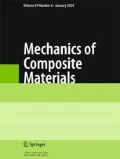To meet the aviation and aerospace requirements for detachability and load-carrying capacity, a novel connecting structure — a carbon-fiber-filament-wound composite tube with grooved metal inserts has been developed. The tensile behavior of the structure was investigated experimentally and by the finite-element method. The finite-element method was used to simulate the damage process. The failure load of the structure was found to be 37% higher than that of an ordinary bonded tube without grooved metal inserts. A stress analysis showed that the structural failure was not caused by the failure of adhesive, but was determined by the tensile strength of the ±30° wound layers and the shear strength of interlayer










Similar content being viewed by others
References
P. P. Camanho and F. L. Matthews, “A progressive damage model for mechanically fastened joints in composite laminates,” J. Compos. Mater., 33, No. 24, 2248-2280 (1999).
P. P. Camanho and M. Lambert, “A design methodology for mechanically fastened joints in laminated composite materials,” Composites Science and Technology, 66, No.15, 3004-3020 (2006).
B. Kolesnikov, L. Herbeck, and A. Fink, “CFRP/titanium hybrid material for improving composite bolted joints,” Composite Structures, 83, No.4, 368-380 (2008).
B. Aidi and S. W. Case, “Experimental and numerical analysis of notched composites under tension loading,” Applied Composite Materials, 22, No. 6, (2015).
C. Xiaoquan, “Evaluation of tensile properties of a composite-metal joint with a novel metal insert design by experimental and numerical methods,” Chinese Journal of Aeronautics, 30, No. 3, 1004-1011 (2017).
D. G. dos Santos and R. J. C. Carbas, “Reinforcement of CFRP joints with fibre metal laminates and additional adhesive layers,” Composite Part B, 165, 386-396(2019).
A. Parashar and P. Mertiny, “Effect of FRP pipe scaling on its adhesive bonding strength,” Journal of Adhesion, 88, No.10, 866-880 (2012).
H. Tang and L. Liu, “A novel metal-composite joint and its structural performance,” Composite Structures, 206, No. DEC, 33-41 (2018).
W. Tu, “Comeld™ joints: optimisation of geometric parameters of the protrusions,” Queen Mary University of London (2011).
B. Larry and B. Victor, “Effectiveness of z-pins in preventing delamination of co-cured composite joints on the example of a double cantilever test,” Composites Part B Engineering, 37, No. 4-5, 365-378(2006).
J. Hun, J. H. Kweon, and J. H. Choi, “Fatigue characteristics of stainless steel pin-reinforced composite hat joints,” Composite Structures, 108, No. feb, 49-56 (2014).
S. Liyang and C. Mantell, “Finite element modeling of the filament winding process,” Composite Structures, 52, No. 3, 499-510 (2001).
H. Hernández-Moreno, et al., “Influence of winding pattern on the mechanical behavior of filament wound composite cylinders under external pressure,” Composites Science & Technology, 68, No. 3-4, 1015-1024 (2008).
M. Menshykova and I. A. Guz, “Stress analysis of layered thick-walled composite pipes subjected to bending loading,” International Journal of Mechanical Sciences, 88, 289-299 (2014).
V. V. Bolotin, et al., “Analysis of the technological stresses in wound components made out of composites during the whole duration of the preparation process,” Mechanics of Composite Materials, 16, No. 3361-368 (1980).
R. A. Turusov, et al., “Technological monolithic character of shells formed from polymeric composition materials,” Mechanics of Composite Materials, 23, No. 6, 773-777 (1987).
H. Altenbach, et al., “Prediction of accumulation of technological stresses in pipeline upon its repair by a composite band,” Mechanics of Composites Materials, 51, No.2, 139-156 (2015).
A. Yu. Sergeyev, et al., “Stresses arising during cure of the composite wound on the cylindrical surface of an element of exhaust system,” Mechanics of Composite Materials, 51, No.3, 321, 332 (2015).
Z. Hashin, “Failure criteria for unidirectional fiber composites,” Journal of Applied Mechanics, 47, 329-34 (1980).
C. H. Huang and Y. J. Lee, “Experiments and simulation of the static contact crush of composite end frame structure,” Composites structures, 61, No. 3, 265-70 (2003)
J. Ye, et al., “3D explicit finite element analysis of tensile failure behavior in adhesive-bonded composite single-lap joints,” Composite Structures, 201, No. OCT, 261-275 (2018).
J. Ye, et al., “An integrated constitutive model for tensile failure analysis and overlap design of adhesive-bonded composite joints,” Composite Structures, 223, No. SEP, 110986 (2019).
M. L. Benzeggagh and M. Kenane, “Measurement of mixed-mode delamination fracture toughness of unidirectional glass/epoxy composites with mixed-mode bending apparatus,” Composites Science & Technology, 56, No. 4, 439-449 (1996).
P. P. Camanho and C. G. Davila, “Mixed-Mode Decohesion Finite Elements for the Simulation of Delamination in Composite Materials,” NASA Technical Report, 2002-211737(2002).
P. M. Wild and G. W. Vickers, “Analysis of filament-wound cylindrical shells under combined centrifugal, pressure and axial loading,” 28, No. 1, 0-55 (1997).
J. S. Park, C. S. Hong, and C. G. Kim, “Analysis of filament wound composite structures considering the change of winding angles through the thickness direction,” Composite Structures 55, No. 1, 63-71 (2002).
J. C. Velosa, et al., “Development of a new generation of filament wound composite pressure cylinders,” Composites Science & Technology, 69, No. 9, 1348-1353 (2009).
F. G. Yuan, W. Yang, and H. Kim, “Analysis of axisymmetrically-loaded filament wound composite cylindrical shells,” Composite Structures, 50, No. 2, 115-130 (2000).
C. U. Kim, et al., “Optimal design of filament wound structures under internal pressure based on the semi-geodesic path algorithm,” Composite Structures, 67, No. 4, 443-452 (2005).
Z. Changliang, et al., “Delamination prediction of composite filament wound vessel with metal liner under low velocity impact,” Composite Structures, 75, No. 1/4, 387-392 (2006).
Author information
Authors and Affiliations
Corresponding author
Additional information
Russian translation published in Mekhanika Kompozitnykh Materialov, Vol. 57, No. 3, pp. 535-552, May-June, 2021.
Rights and permissions
About this article
Cite this article
Li, Y.D., Luo, H.B., Yan, Y. et al. Experimental and Finite-Element Analysis of Metal-Inserted Filament-Wound Composite Tubes. Mech Compos Mater 57, 373–386 (2021). https://doi.org/10.1007/s11029-021-09961-2
Received:
Revised:
Published:
Issue Date:
DOI: https://doi.org/10.1007/s11029-021-09961-2




